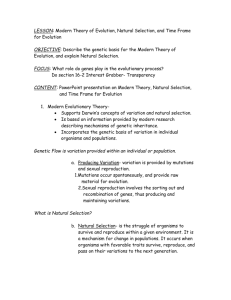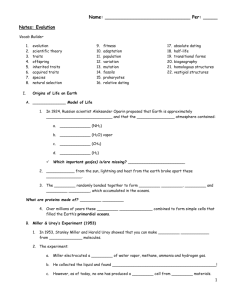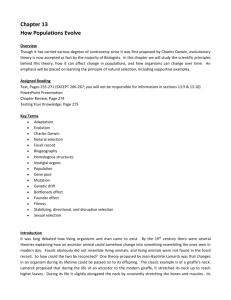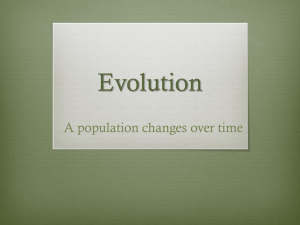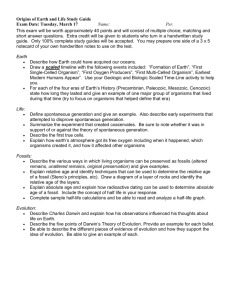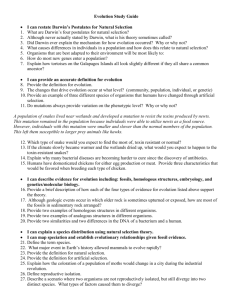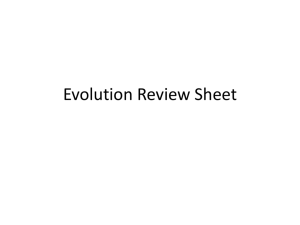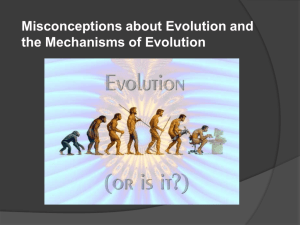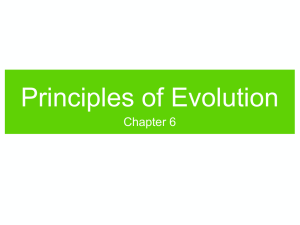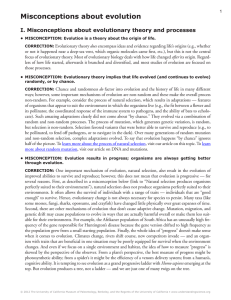Darwin and Evolution
advertisement
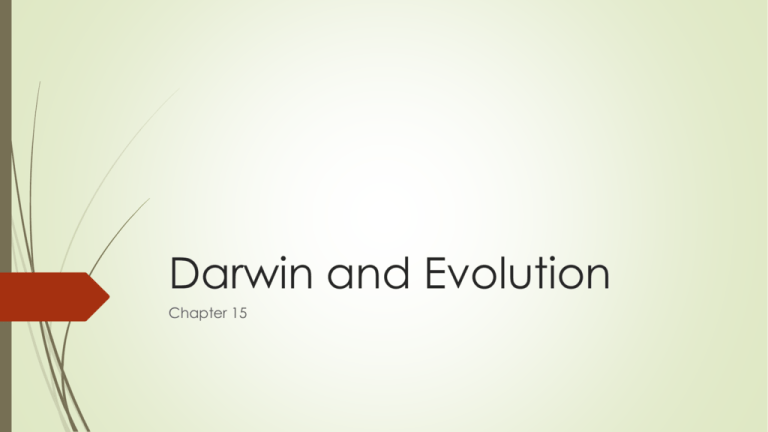
Darwin and Evolution Chapter 15 Objectives Identify historical figures and their viewpoints before and during the development of Darwin’s theory. Summarize the process of evolution through natural selection. List examples of evidence that support shared ancestry Give examples of how evolutionary change can be studied Give an example of supporting evidence of evolution for each area of its study. Interpret misconceptions of evolution. Misconception: Evolution is a theory about how life originated. Truth: Evolution deals with how the diversity of life emerged following the origin of life. Misconception There are no transitional fossils. Truth There are transitional fossils. Scientists cannot expect to find a transitional fossil for every species because the process for a fossil to be formed is very specific. Misconception Evolution proposes that life changed as a result of random events; traits are much too complex to have come about “by chance” Truth Mutations create new variation in populations randomly. Natural selection can only act upon variations existing in the population. Complexity resulted from millions of years of modifications on existing traits. Misconception Evolution is not observable or testable; thus, it is not science. Evolution is both observable and testable. Evolution has 150 years of supporting evidence from a wide variety of scientific disciplines. New variation can arise from small changes to single genes. Population traits change in response to environmental changes. Evolution Evolution is change over time. History of Evolutionary Thought- Mid 18th Century Influences Plato- Organisms have an “essential” form and variation on that form gives rise to species Aristotle- organisms vary in complexity Count Buffon- described all known plants and animals and proposed environmental influence and the struggle for existence as evidence for evolution Linneaus- believed in the fixity of species and developed a binominal nomenclature system Erasmus Darwin- believed species evolved but did not offer a mechanismbased his conclusions on vestigial structures, developmental changes of animals, and animal breeding by humans. History of Evolutionary Thought- Late 18th/Early 19th Century Baron Georges Cuvier-Proposed the theory of catastrophism. Lamarck- inheritance of acquired traits Hutton- proposed the theory of uniformitarianism Malthus- proposed that the human population size is limited by the quanity of resources Darwin’s Theory of Evolution Darwin Studied at Christ’s College with the intent of becoming a clergyman Served as a naturalist aboard the HMS Beagle for 5 years to explore the Southern Hemisphere Observations of Change over Time Observed long spans of beaches strewn with fossils Saw marine shells high upon mountains Began to accept that possibility of the Earth being very old Descent with modification could occur Biogeographical Observations Geographical distribution of species provide evidence and hints for past geological events. Similar environments on different continents have similar looking organisms. Differences among organisms was correlated with variations in the environment Natural Selection Organisms exhibit heritable variation. We now know about genes and mutations. Genetic mutation can be helpful, harmful, or neutral. It is random. Helpful and harmful traits are maintained in a population. Because the natural selection is random and beneficial mutations have greater reproductive successthere is no goal of improvement in anticipation of future changes Organisms compete for natural resources Fitness is reproductive success relative to other population members. Individuals within a population differ in terms of reproductive success. The more fit, the more resources, the more chances to reproduce and pas on traits. Organisms adapt to conditions as their environment changes. An adaptation is any evolved trait that helps an organism be more suited to its environment. Differential reproduction in subsequent generations increases frequency of traits adapted to an environment https://youtu.be/0SCjhI86grU Artificial Selection Artificial selection provides the ability to see selection at work. Plants Dogs Peppered-Moths Bacterial Resistance Evidence for Evolution https://youtu.be/lIEoO5KdPvg Evidence for Evolution- Fossils Evidence for EvolutionBiogeographical Evidence for Evolution- Anatomical Evidence for Evolution- Biochemical Evidence for Evolution- Developmental Biology

